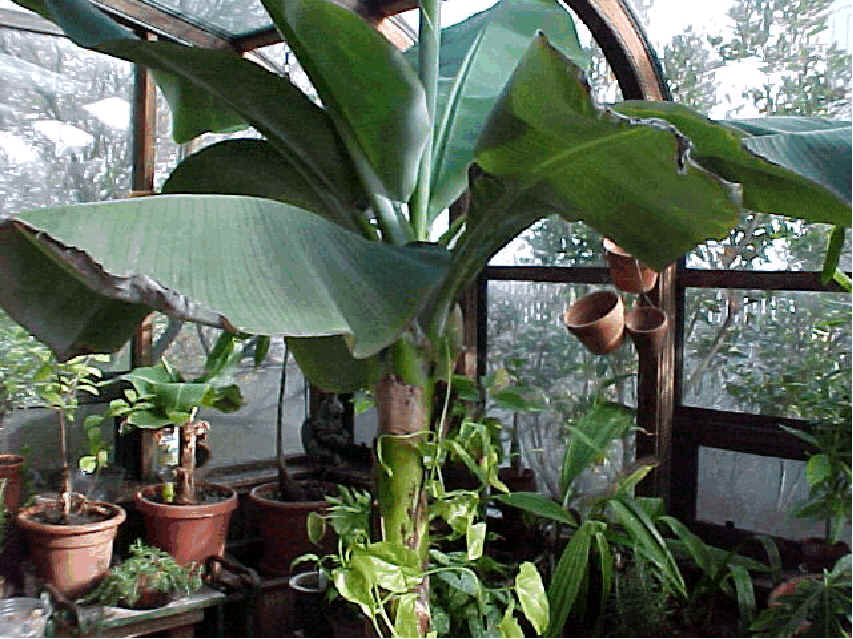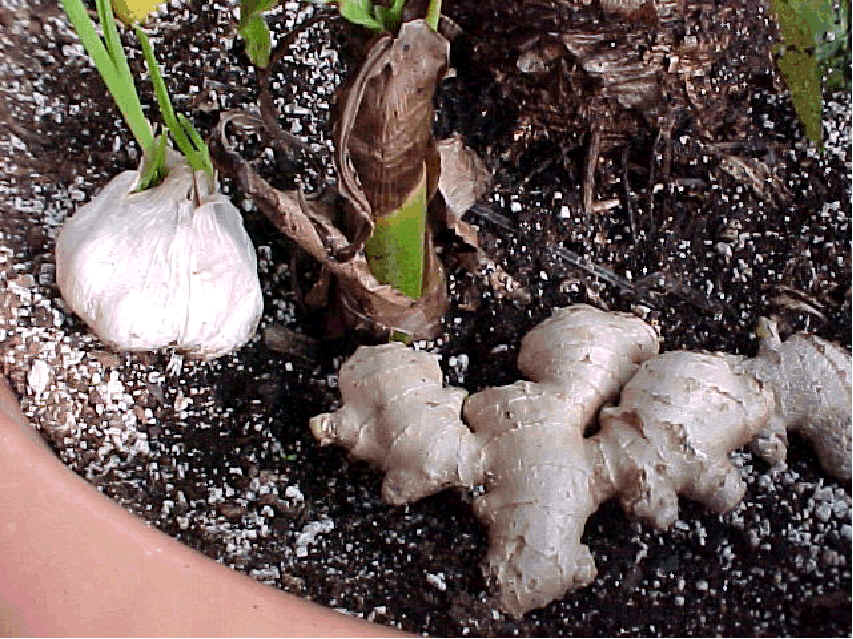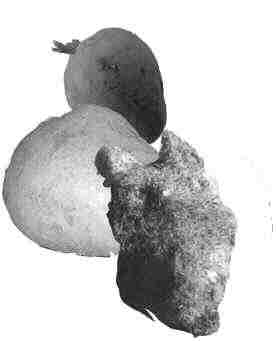

PITS NEWSLETTER
Volume 22 #2
Winter 2004
(Zingiber officinalis)
To grow:
Ginger is one of the simplest pits to grow. Purchase a plump rhizome (called a hand) that has several swollen white, pink tipped nubs. Choose at pot that is large enough to accommodate the rhizome horizontally. Fill the pot with moist, sterile soil, lay the rhizome on top, sprinkle a thin layer of soil over the rhizome - some of it should be above the soil. Put a light plastic cover over the pot to insure humidity, and if possible give it some bottom heat. Green shoots should appear in about 10 days. In the summer, put your plant in the garden. The rhizome will double or triple in size. Harvest before frost and you will have grown enough ginger to last for months. The stalk that bloomed will die back, but a new stalk will appear.
The Banana Nursery
We have discovered the large (36 inch pot) that holds our 7 foot Banana tree is an excellent nursery for a wide variety of tubers and bulbs. Previously we have always suggested using a sphagnum back for these


1. Banana 2. Name 1. Garlic 2. Ginger 3. Sprouting Banana corm
large tubers. Sometimes the tubers would rot because the bag was too dry and other times they would dry out. With this system, they seem to get just enough water when I water the soil around the Banana and they don’t seem to need the bottom heat.
You don’t have to go out and buy either Banana or a 36" pot Just fill any large pot or container with soil. It should be large enough to accommodate any tubers or bulbs without letting them touch each other. These large tubers are full of water and will not require additional water until they sprout.
A word of warning: Move the plants along. The large Name that is climbing the Banana has become too large to move and is currently forming little Names beneath the soil. I may have to commit ‘herbicide’ if the Banana starts to fail. The Ginger and Garlic have since been moved to pots of their own and been replaced with a Malanga. Keeping the base of this pot filled has served another purpose--the cats no longer think it’s a litter box.
Name (
Pronounced: En Yami)(Dioscorea esculenta)
Names are sold in Latin and Asian markets year round. These large tubers
(1-3 lbs) are a dark dusky brown and slightly hirsute (hairy) and come in
odd shapes resembling parts of the human body, hands and feet. Smaller ones
may be oblong or oval and be easily confused with other tubers in the
market. The other tubers, Malanga and Taro have horizontal bands, Names have
no bands.
brown and slightly hirsute (hairy) and come in
odd shapes resembling parts of the human body, hands and feet. Smaller ones
may be oblong or oval and be easily confused with other tubers in the
market. The other tubers, Malanga and Taro have horizontal bands, Names have
no bands.
It is difficult to tell what end is up and what is down. Sometimes you can see old roots at the base, but it is not necessary to know this. You can uses a sphagnum bag, but it is just as easy to lay it horizontally on the top of a large pot filled with barely moist soil. There will be no need to water it, until the tuber begins to shrink and the vine is 2-4 feet tall.
The vine emerges long before the roots and you must have a wire, string, or trellis for it to twine around. A friend of ours left her Name on the terrace of her 16th floor apartment for the summer when she took off for Canada. It crawled up the wall on an outside wire and climbed through the upstairs apartment’s air conditioner. The neighbors had to hack away at it all summer. When my friend returned, she chopped the vine down and found her planter full of small Name tubers.
When we lived in New York, we had a small city garden surrounded by a rickety wrought iron fence. In May I would plant an Name in a large planter and by mid-June the fence would be completely obscured by the vine. Name is deciduous and in the late fall, the leaves turn yellow and drop. At this time a Columbian friend would harvest the tubers that formed over the summer. The vigor of this vine cannot be underestimated.
To Eat: Peel, boil until tender and mash. Name is not as sweet as the Supermarket Yam and needs a little help. Add 1/4 cup of orange juice (or other favorite juice) to 1 ½ cups of Name, butter and heavy cream or sour cream until it has a nice fluffy consistency.
There are three kinds of Names. They all have lovely 4 inch heart-shaped, glossy, light green leaves that are deeply veined. The differences are in the stems. The most common variety has a cylindrical stem about 1/4" in diameter, our favorite has a ‘winged stem’ (a thin opaque pale pink flat membrane that is slightly ruffled surrounds the stem) and the last is what my children used to call a ‘Martian plant’ small round growths that look like tiny space ships develop on the stem. The latter also has some thorns. We have combed the literature searching for a clear definition of each Name to no avail. If anyone finds the answer, please write to us. No matter what Name you are growing, they are lots of fun and attractive to boot.